ISSN ONLINE(2319-8753)PRINT(2347-6710)
ISSN ONLINE(2319-8753)PRINT(2347-6710)
K. Surya Kumari, V. Lakshmana Rao, K P R Vittal Murthy.
|
| Related article at Pubmed, Scholar Google |
Visit for more related articles at International Journal of Innovative Research in Science, Engineering and Technology
Innovative thinking led to find various techniques by which alcohol can be used as fuel in diesel engine, amongst the fuels alternative proposed, the most favourest ones are methanol and ethanol . so far no established method is available to run a normal diesel engine with a compression ratio from 14:1 to 20:1 by using alcohol as fuel.This is because, the properties of diesel engine fuels differs from the properties of diesel fuels . The specific tendency of alcohols to ignite easily from a hot surface makes it suitable to ignite in a diesel engine by different methods .The advantage of this property of alcohols enables to design and construct a new type of engine called surface ignition engine. In this work it is tried to bring out the advantages of additives to alcohol fuel on the performance of CI Engines. The Additives such as n-butanol,hexanol, 1-octylamino-3octyloxy-2propanol&N-octyl nitramine had been mixed with the blends of diesel & ethy alcohol and experiments are carried out.the present research work is proposed to carry out the experimental investigation on a ceramic hot surface ignition engine by adding Ethylnitrate,Butylnitrate,Diisipropylether and Dimethylether as additives to ethanol/methanol as a fuel with an objective to find the best one interms of performance ,emission and combustion parameters.
Keywords |
| Ecofriendly vegetation, Pollution, Urban atmosphere, Industrial and Residential. |
INTRODUCTION |
| Last five decades in India witnessed rapid industrialization and subsequent urbanization. Naturally the needs of the increasing population are also on the rise this resulted in over exploitation of the available natural resources. The energy needed for the alarming growth of industries and urban centers also increased abnormally resulting in pollution of air water and soil. The available land is depleted at a rapid rate. There is an increase and accumulation of solid waste. The polluted water disposal also becomes practical problem. The vegetative cover and the animal kingdom and the birds in the urban centers decreased. In short man is making rapid strides of progress in science and technology by over exploiting natural resources aimed at providing humanity with better comforts. Which results in the pollution of city atmosphere, the lack or bad quality of drinking water, overcrowding, traffic congestion decrease in greenery and in nutshell a deterioration in the quality of urban life? The atmosphere serves only as a dumping platform for gaseous and suspended particulate wastes which result in the decrease of much needed oxygen as an essential in gradient for human survival. The aim and objective of the present article is not only to present the urban air pollution scenario but to suggest eco friendly vegetation which in turn increases greenery decreases the pollution and moderates the urban temperature. In the present article a solution is clearly explained aimed at increasing eco friendly vegetation which not only decreases the magnitude of air pollution, moderates the temperature but also increases the greenery of urban atmosphere and comfort of living population. Vijayawada is a commercial centre and historical city situated at the geographical center of AP state in India. It is situated on the banks of the river Krishna. (latitude 16ÃÂ03’ 11” N and longitude 80ÃÂ03’91” E) the climate is tropical with hot summers and moderate winters. The city is peculiar in its own geographical setting. The city is surrounded by hills on all sides with Indrakiladri Hill range on the west where the famous shrine of the Kanaka Durga is situated on the east side there is Mogalrajpuram hill range with a famous temple of the holy mother Mary. The Krishna River also forms a natural boundary on the southern side; the “Budameru Vagu” forms the boundary on the Northern side. There are three canals within the city. The Bandar canal, the Rivas Canal in the center and the Eluru canal on the north. At present Vijayawada, is having all the bad situations of a typical urban center. The canals in the summer will have nothing but drainage effecting the health of the surrounding population in the neighborhood. There is an alarming decrease in vegetative cover resulting in extreme temperatures in the summer. Popularly Vijayawada called as Bezwada by the Britishers is termed as Blazewada (meaning burning city). The peak temperature in the month of may reach 47ÃÂC and the rainfall of the city is 103 cm. the growth of population has been rapidly increasing and is almost three folds in three decades. According to this senses of 2011 the population is 8.45 lacks and the population density 15600 / Sq.Km. it is the third largest city in the state and largest city in Krishna Dist. Vijayawada particularly has a lot of scope for increasing Eco friendly vegetative cover which will make the city more comfortable and less polluted. |
DATA AND METHDOLOGY |
Sources of Air Pollution in Vijayawada City |
| Industries: there are both major and minor industries in and around Vijayawada one of the major industry is the Vijayawada Thermal Power Station (VTPS) located at Ibhrahimpatnam on the west side of Vijayawada. The medium and small scale industries are predominantly Agro based. There are solvent extraction plants, rice mills and Dall mills etc. there are two industrial estates around the city, Autonagar industrial estate located on the eastern part of the city covering 340 Acres. The other industrial estate is at Kondapalli on the western side of the city extending over an area of 439 Acres. As far as the meteorological wind directions are concerned the pollution arising from Kondapalli moves away from the city during the southwest monsoon season however Autonagar pollution spreads to the city interior so the location of the Kondapalli industrial area is better compared to Autonagar. |
| Traffic pollution: Vijayawada is well connected to the rest of the country by national highways NH- 5, NH – 9 and NH – 221. There are a number of heavy trucks, busses, lorries, cars, three wheeler autos as well as scooters plying on this national highways besides the floating population all major streets within the city are connected with local public transport as well as individual transport like cars and scooters the three wheeler autos are the major source of transportation for middle class population. All these contribute to traffic air pollution in the city. In the present article the pollution levels at two places. |
| 1. Benz Circle which is predominantly traffic polluted and |
| 2. Autonagar which is predominantly industrial polluted area. |
| The pollution levels at this two sampling points where presented for the years 2010, 2011 and 2012. |
| ANDHRA PRADESH POLLUTION CONTROL BOARD:: ZONAL LABORATORY :: VIJAYAWADA NAMP AVERAGES (BENZ CIRCLE & AUTONAGAR) FROM JANUARY – 2010 TO DECEMBER -2010 |
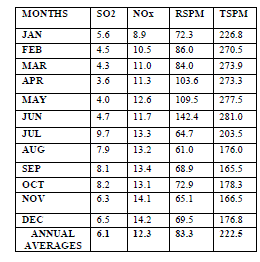 |
| ANDHRA PRADESH POLLUTION CONTROL BOARD:: ZONAL LABORATORY :: VIJAYAWADA NAMP AVERAGES (BENZ CIRCLE & AUTONAGAR) FROM JANUARY – 2011 TO DECEMBER -2011 BENZ CIRCLE AUTONAGAR |
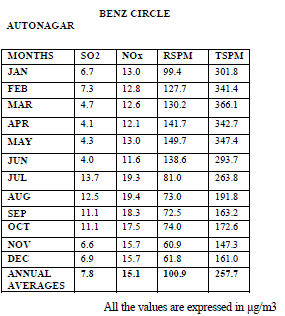 |
 |
 |
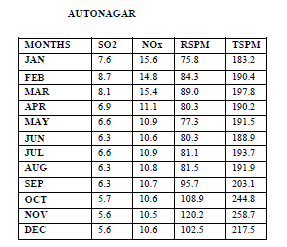 |
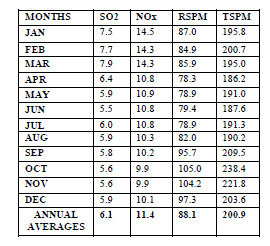 |
| All the values are expressed in μg/m3 All the values are expressed in μg/m3 |
| In the present article the vegetation effect with air pollution namely whether it is resistant or sensitive to air pollution was also estimated by following a methodology based on as Ascorbic Acid level. Ascorbic Acid Index (AAI): plants play an important role in monitoring and maintaining the ecological balance by actively participating in the cycling of nutrients and gases like CO2 and O2 and also provide enormous leaf area for impingement absorption and accumulation of air pollutants to reduce the pollution level in the air environment ( Escobedo et , al; 2008) . Sensitivity and response of plants to air pollutants is variable. Plants in an area farms integral basis for all eco systems and also most likely to be effected by air bone pollution which are indentified as the organisms with most potential to receive impacts from ambient air pollution the response of plants towards air was assessed by air pollution tolerance index. The usefulness off evaluating APTI for the determination of tolerance or sensitiveness of plants species was estimated by several authors ( Agrawal and Tiwari 1997; Dwivedi and Thripati 2007, Liu and Ding 2008; Dwivedi et al; 2008). These studies provided valuable information for landscapers and green belt designers to select the sensitive as well as tolerant varieties of plants species for using them to indentify the pollution loads of urban / industrial areas and also to use the tolerant varieties for curbing the menace of air pollution. |
| Materials and Methods: To indicate the susceptibility level of plant, population - induced changes in individual parameters are usually quantified and correlated with the level of plant response. The combination of the biochemical and physiological parameters gave a more reliable result than those of individual parameter therefore combination of parameters like Relative Water Content (RWC) total chlorophyll (T), PH value (P) and Ascorbic Acid (A) to pollution tolerance in the plants were considered in this study. In the present article plants species around Vijayawada at six different zones were studied. APTI is determined using the following equation (Singh and Rao 1983) |
| APTI = (A x (T+P) + R) / 10 |
| Where A is Ascorbic Acid (mg/g) |
| T is Total chlorophyll (mg/g) |
| P is PH of leaf extract and |
| R is Relative Water Content (%) |
| The APTI index range is as follows |
TABLE- I |
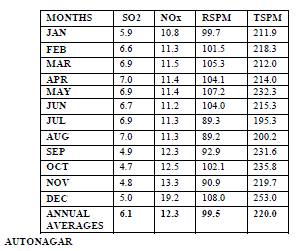 |
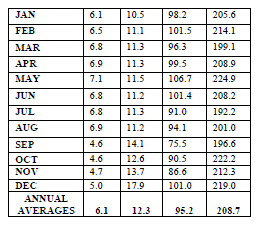 |
| A new index based on Ascorbic Acid (AA) level in vegetation: |
| After a careful examination of APTI we have observed the following. It is the AA that is very important parameter which decides tolerance of a plant species. The AA is very important in determining the nutrition and plant growth. So one can say that the important parameter in determining air pollution tolerance of plants is AA. In the present article AA is taken as an index in order to get a non dimensional index of AA. All the values of AA are divided by the minimum value of AA which is in Antygonum leptopus (2.2) and the index is observed varying between 1 and 8. So much so the newly derived index, |
| AAI = Ascorbic Acid in a sample / Ascorbic Acid minimum |
| AA ordinate and the plant spices on the axis showed a variation between 1 and 8. Keeping in view the AAI tolerance the plants were conveniently grouped as follows |
Tables II &IIA |
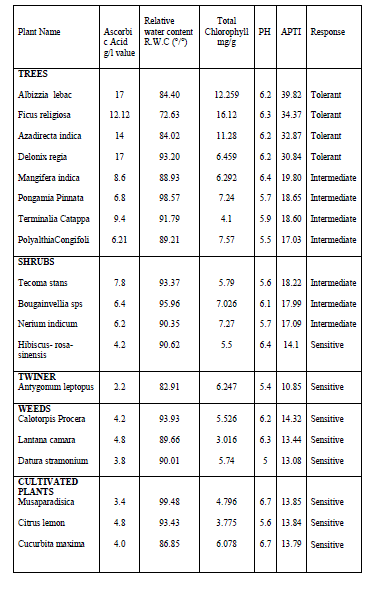 |
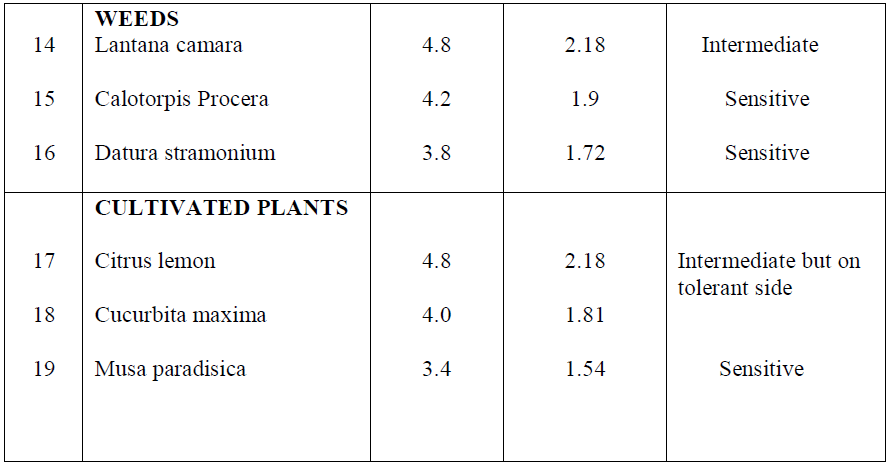 |
| Ascorbic Acid new index (AAI) values, the plants were conveniently grouped as follows. |
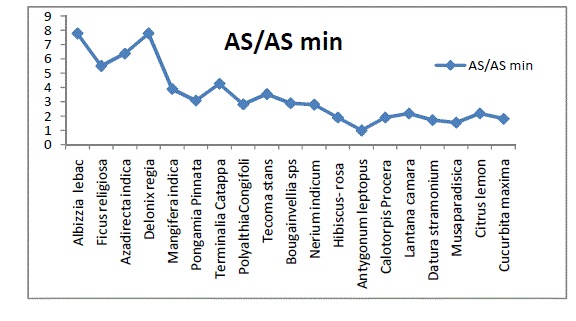 |
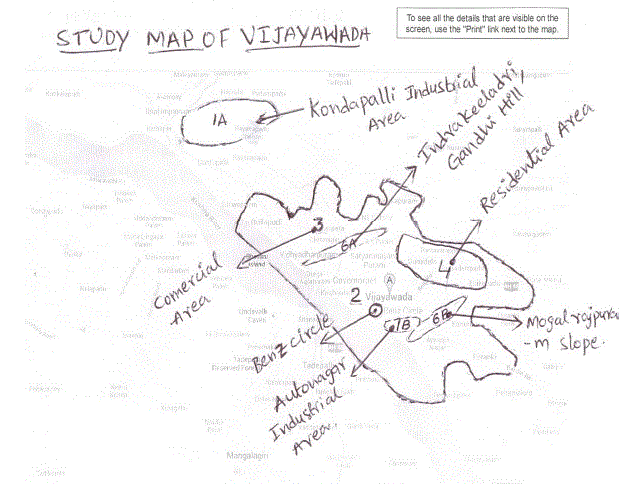 |
| Above figure shows the physical map of Vijayawada. The Vijayawada urban area can be divided into 6 different zones |
| 1A – Kondapalli Industrial area |
| 1B - Autonagar Industrial area |
| 2 - Benz Circle |
| 3 – Commercial Area |
| 4 - Residential Area |
| 5 – Area along the side of three canals |
| 6A- Indra Keeladri, Gandhi hill |
| 6B - Mogalrajpuram slopes |
RESULTS AND DISCUSSION |
| In the present article the air pollution concentrations of conventional pollutants like SO2, NOx, RSPM and TSPM have been observed at two locations namely Benz circle and Autonagar. The former is having air pollution predominantly due to traffic and Autonagar is having pollution due to existing industries. The concentrations are observed for three consecutive years namely 2010, 2011 and 2012. The 2010 concentrations of SO2 and NOx in traffic predominant area follow a definite trend. The concentrations are high from July to January, February, March, April and May showed a relatively lesser concentrations in 2010. The NOX concentrations are high in the summer months also. However in winter the concentrations are high, it should be mentioned here that the concentrations are less in comparison with threshold limit value (TLV) which is 80 for both SO2 and NOX. However in case of TSPM and RSPM are at time higher and always comparable with TLV values which are 100 μg / m³ In 2010 RSPM is above TLV in the months of April, May and June. The TSPM is greater than TLV (100 μg / m³) in all the months of the year in the year 2011 the SO2 and NOX followed the same trend, however the NOX values are slightly and comparatively higher in 2011 it is interesting to note that RSPM exceeded TLV only in 2 months October and November however TSPM is always higher in all the months as in 2010. In industrial area the concentrations of SO2, NOX, RSPM and TSPM are relatively high in all the years 2010, 2011 and 2012. Having estimated and gained an area about the existing levels of pollution now one is in a position to suggest the types of vegetation in different zones of the city. In order to suggest the type of vegetation one should know the character of the zone as to |
| 1. Type of the soil |
| 2. Available water in that particular zone and |
| 3. Intensity of pollution |
| Besides this the Vijayawada urban area is having 3 canals flowing through the city. This gives another zone which is on the banks of these canals, which can be encouraged to grow lush green vegetation. Another peculiar zone typical for Vijayawada is the slopes of the surrounding hills. Environmentalists opined that bare hills devoid of vegetation adds to the temperature in the city. In this case the resulted temperature is not only from the direct solar radiation but also the one reflected from the hills. So the planning of suitable vegetation over the hill will reduce the temperature. There is a hill opposite to Vijayawada Railway station where Gandhi Statue is situated lot of vegetation is planted on the hills. It is observed both the temperatures as well as reflected radiation were reduced encouraged by this several environmentalists suggested raising vegetation on the slopes of the hills. However if only a proper planning was envisaged at that time the project initiated by Dr. K. L Rao the famous engineer and environmentalist would have resulted in better results. Now at least the same project can be initiated by way of spreading seeds by means of helicopters. However environmentalists with good knowledge of type of vegetation which can withstand poor soil condition and hills terrain should be encouraged then the city will definitely have lesser pollution and moderation in temperature. |
| With this background we have studied number of plant species which show varying degree of tolerance to air pollution. The botanical knowledge is handy in determining the optimum soil type and soil moisture with this background we made a study to suggest different types of vegetation for different zones of Vijayawada. |
| 1. Industrial Area: this zone is dominated by industries will have industrial air pollution so the plant species or vegetation planned in the city should have resistant species to air pollution. In methodology based on AA level and the indices of APTI and AII are already suggested. The author recommends the type of vegetation which thrives well in this zone. There are two industrial areas in this city, in the north the industrial area is in Kondapalli covering an area of 439 acres. The industrial area which is situated in the southern part of the city is Autonagar covering an area of 340 acres. The resistant variety of vegetation suggested in the area should thrive under heavy polluted environment. So much so there would growth in vegetation and this vegetation can filter the particulate pollutants. Mentioned should be made here that near Kondapalli industrial area the NTTPS was situated which to be dealt separately this gives rise to lot of pollution and the vegetation and the crops in the surrounding can be suggested in similar lines. However this needs a separate scientific study which not only point out the extension of pollution but also the extent of reduction in the pollution levels after planting the trees. |
| 2. Predominantly Traffic area: this zone is the neighborhood of state and national highways which will have lot of vehicles plying on the highways which results in the pollution arising due to traffic with the increase in traffic density the traffic pollution is on the rise. Here the trees along the highways are exposed to heavy traffic pollution so much so this zone also requires such type of trees which can with stand traffic pollution but will not be an abstraction to traffic. So the trees should not spread horizontally on the highways. They should withstand the turbulence caused by the speedy vehicular traffic along the highway. |
| 3. Commercial area: the commercial area in Vijayawada which is commercial capital of Andhra Pradesh almost occupies ¼th of the total city area. However it is difficult to suggest the plant species because this commercial area is having tall buildings and narrow roads particularly devoid of vegetation. The vegetation to be grown here should be innovative. Creeper type of plants which can grow on the terrace of the buildings and can come down. Optimum care should be taken to water them regularly there the vegetation can grow well as in the case of Buenosaires the capital of Aregentina. |
| 4. Residential area: the residential sectors are being developed at the periphery of the city. So the type of vegetation should be different for different types of residential complexes. So the type of vegetation should be different type of vegetative cover compare to the individual houses. It is strongly felt here that the vegetative cover for the upcoming residential complexes should be made compulsory. |
| 5. Area along the side of 3 canals: the plants along the side of canals will have ample supply of water from the canals and add to the greenery west is to develop parks and waking tracks. The municipal corporation should be given the responsibility to look after the parks along the banks. It is worth mentioning here that such a park has been developed on Krishna River which is added tourist attraction and generates revenue for the corporation. |
| 6. Hill slopes area: the last zone is the hill slopes. Here the soil is scarce and it is rocky type so the plants which can survive such conditions as well as the slope, should be selected. Prosopis cineraria can thrive not only in poorly nourished soil but also in water stress conditions. |
SUMMARY AND CONCUSSIONS |
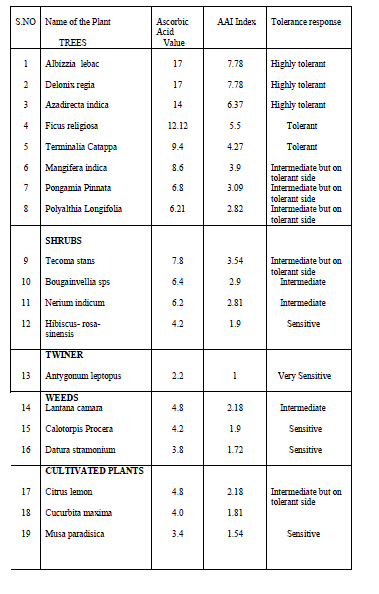 |
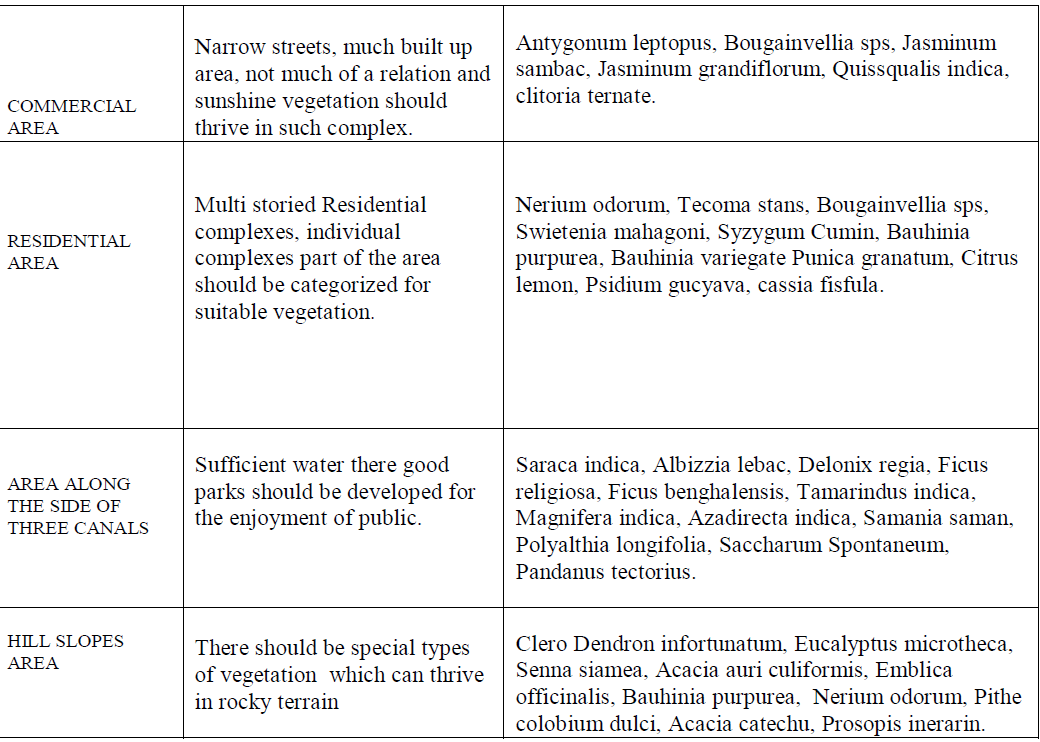 |
References |
|